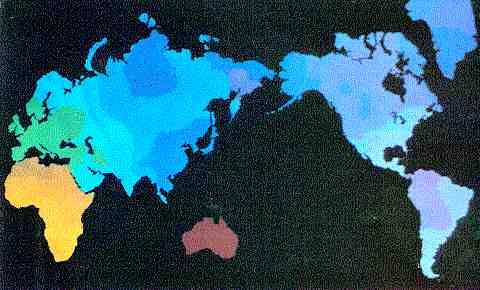Posted: Aug 12, 2011 4:55 am
Haha, maybe you should read it again. Risch is only the 2004 winner of the Curt Stern award for outstanding scientific achievements in human genetics over the preceding 10 years, he has a fair idea about the subject. http://en.wikipedia.org/wiki/Curt_Stern_Award
In terms of your query, according to the sub-species classification approach the qualifying criteria for subspecies is being able to correctly assign ~75% or more members to a population. Refer to: Smith et al., 1997. Subspecies and Classification or Amadon, 1949. The Seventy-Five Per Cent Rule for Subspecies. In terms of human races you can do this using morphological features or by looking at dna. http://www.ln.edu.hk/philoso/staff/sesa ... e=Race.pdf
mcgruff wrote:Do you dispute that the gene map is a series of multiple intersecting clines each following their own selective pressures? Such a pattern does allow an individual to be reliably triangulated to a population (but only if you use many thousands of markers) but that, clearly, is not race. If you used this as your definition of genetic uniqueness you would end up with hundreds of thousands of different races.
You're committing the Lewontin fallacy again. If you look at small numbers of genes you overlook the broader correlational structure that reflects population or racial differences. Similarly, if you just look at a person's ears, or eyes you might struggle to identify their racial group. If you look at more features you'll see they correlate in a way that reflects geographic ancestry.
Of course by looking at one small aspect of something, you deconstruct any number of categories. If you look at the hair at one point at the back of someone's head you could say a 'bald' person actually isn't bald. You need to look at the whole head of course!
You keep talking about clines, but you're overlooking the fact that you get small discontinuous jumps in genetic distance—across oceans, the Himalayas, and the Sahara etc—that lead to the clusters that correspond to geographic regions. Those geographic regions reflect the major races as set out in the diagram above.
mcgruff wrote:Are you serious? "Some guy on a blog" is an authority on race?
Interesting reference to Cavalli-Sforza.Do you know what he had to say about race?
"The classification into races has proved to be a futile exercise for reasons that were already clear to Darwin"
--Cavalli-Sforza
Hsu has just returned from the Beijing Genomics Institute (BGI) he is up with the most cutting edge work in the field. Besides, his post simply provides diagrams from published papers over the past 40 years.
As for Cavalli-Sforza's comment, he started making those comments in the 1990's when he was getting heat for his Human Genome Diversity Project (he was even accused of racism!). Of course he tried to downplay the existence of race (are you aware of the various ethical guidelines for research?). Nonetheless, behind the squid ink he mentions the major racial groups in his book:
The color map of the world shows very distinctly the differences that we know exist among the continents: Africans (yellow), Caucasoids (green), Mongoloids… (purple), and Australian Aborigines (red). The map does not show well the strong Caucasoid component in northern Africa, but it does show the unity of the other Caucasoids from Europe, and in West, South, and much of Central Asia” [The History and Geography of Human Genes , p. 136]

The political aspect to this is something you might not be aware of but it's there nonetheless:
Dr. Stephen O'Brien, a geneticist at the National Cancer Institute, said that the conclusion that race was not a valid concept ''comes from honest and brilliant people who are not population geneticists.''
''That doesn't mean they are insincere,'' Dr. O'Brien said. ''It's just that they haven't really looked at it. What is happening here is that Neil and his colleagues have decided the pendulum of political correctness has taken the field in a direction that will hurt epidemiological assessment of disease in the very minorities the defenders of political correctness wish to protect.''
http://www.nytimes.com/2002/07/30/scien ... d=4&src=pm